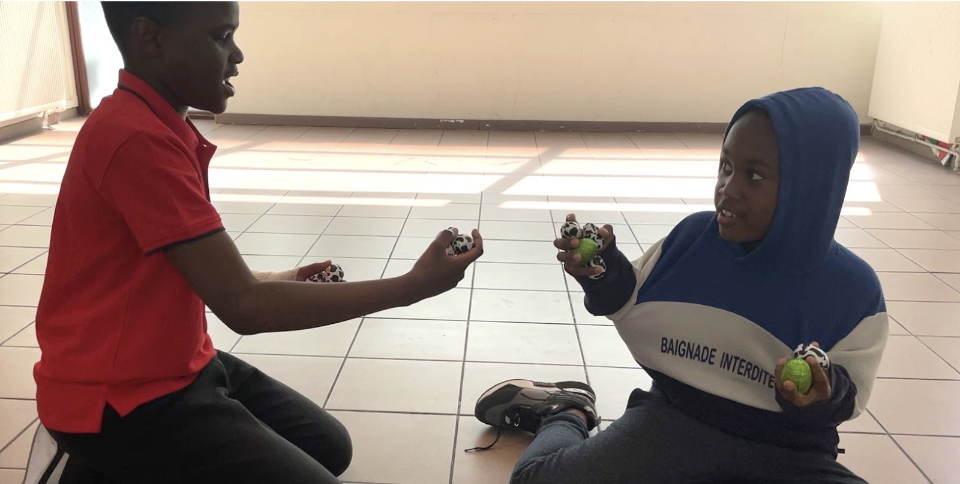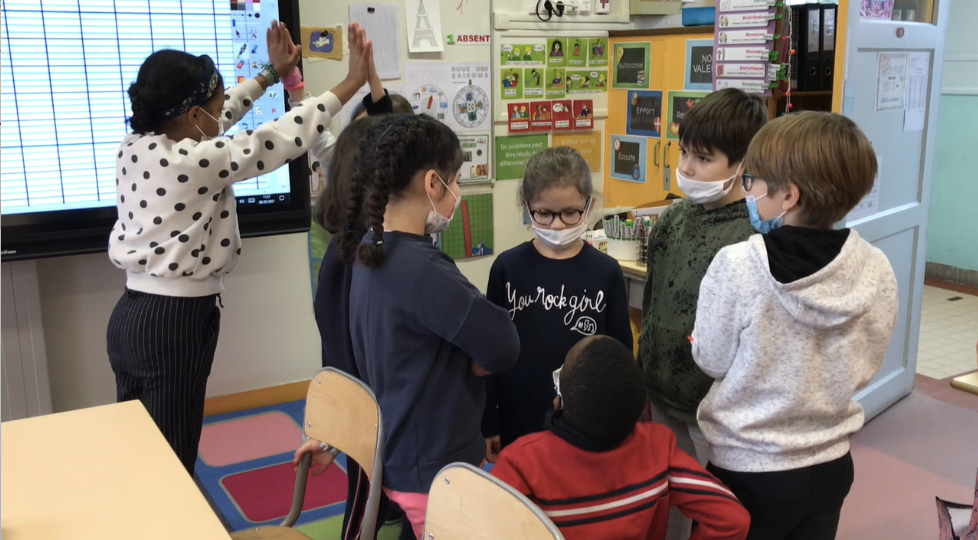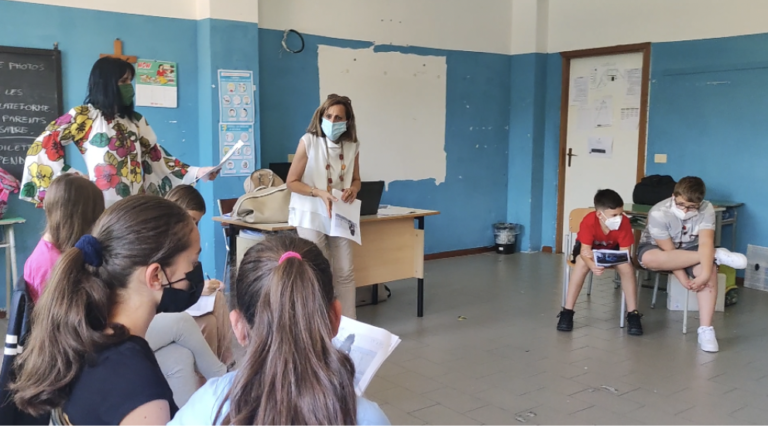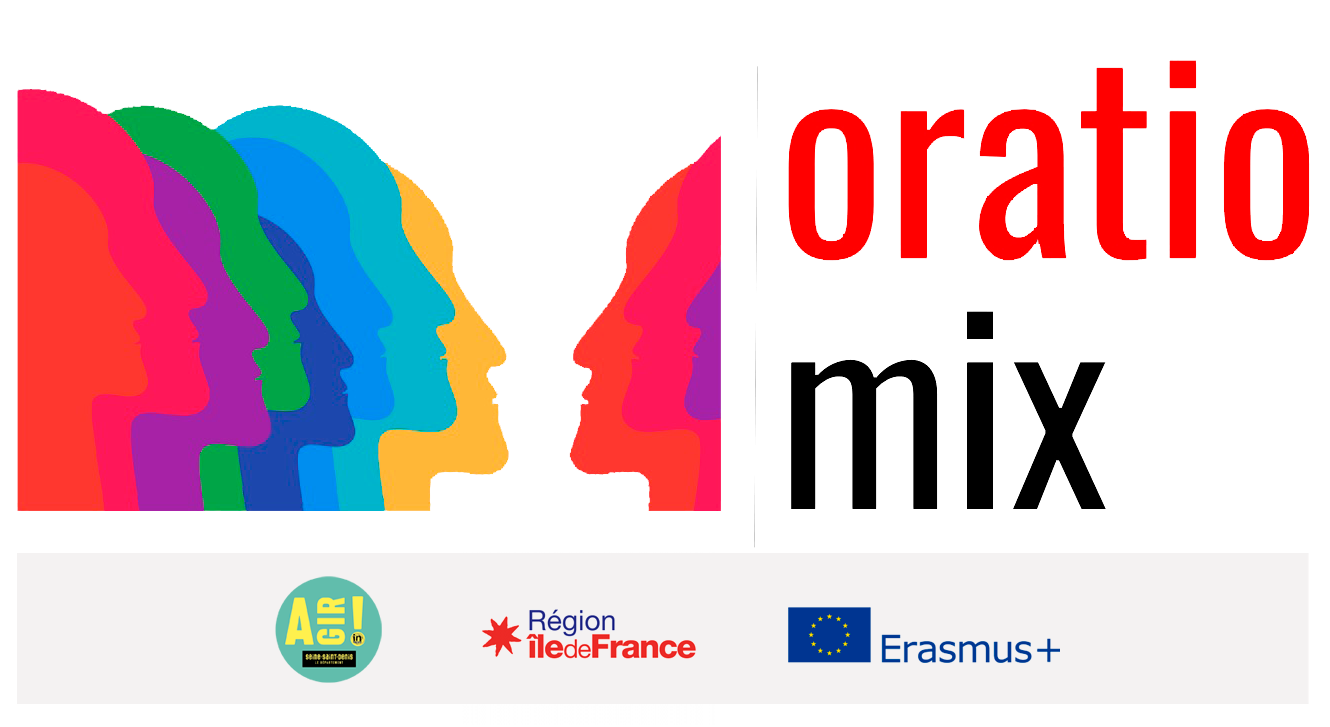Workshop 3
Implementation: what do we need?
– A workspace: the room provided must be large enough and arranged in such a way that it can accommodate all participants and allow freedom of movement, the workshop requiring physical commitment.
The participants
The methodology is aimed at primary and sixth grade students, aged between 9 and 13. Ideally, the group should not exceed 30 students.
Speaker
School teacher, educator, theatre teacher
Objectives of this workshop
Strengthen the capacity for individual and collective reflection around a text.
Reinforce the notions of listening, attention to others and debate.
Time required
90-120 minutes
Implementation
The workshops use techniques of oral expression and debate around a theme related to a source text. They also put into practice, through body expression techniques, the questions theorized by students to allow a global understanding of the issues raised by the text.
Finality
At the end of the session, children will have:
Developed ability to work individually and in groups
Progressed towards acquiring communication skills
Strengthened critical thinking by sharing and discussing symbolic themes present in their stories.
Students’ practice of new oral and physical expression techniques will improve their personal development and communication skills.
1. Start session
In the manner of clapping established as a ritual of end of session, we suggest you to have a recurring exercise to create a ritual of beginning of session. Again, this helps to form benchmarks for students and make them evolve in a reassuring setting. Il.elle. s also better differentiate between the ordinary class, the playground and the theatrical workshops.
The clap
In a circle, the children pass a clap to their neighbor. e (one claps in his hands) while making the circle. For the clap to pass, students must look each other in the eye before clapping their hands!
2. The walk
- You can take the instructions seen last time (walk, stop, youpla, rhythms, numbers) to see the progress of students from one session to another.
Environments: students are offered to move as if they were evolving in very particular and different environments. We evoke in turn a burning sandy beach, a frozen lake (without skates of course), a gum floor on the moon, with lead soles, against the wind, with water to the ankles and then to the thighs and finally to the waist! - We walk in space in the manner of the different characters of tales that have been listed: the princess, the knight, the ogre, the witch, the wolf, the little boy/girl, the fairy, the dragon…
3. The references
Pairs: each student is given a label (see the appendix called Pairs). Each label is associated with another to be able to create pairs. Students must therefore make contact to try to find their partner. Labels refer to famous tales or stereotypes from tales. Thus, the witch is associated with her cauldron and Cinderella with her shoe. Be careful, the wolf could be associated with several other images (the little red riding hood or the 3 little pigs). Students must find the right combination so that no student stays alone! For this, we offer in the image bank the possibility to create a trio if you group is an odd number.
Once the students have all found their pairs, they must mime what they are in order to make the rest of the class guess. The facilitator can help and encourage students on stage by asking questions. For example for the witch and the cauldron: what is the shape of this object and how could you represent this shape with your body (sitting, leaning…), what does the witch do in her cauldron and what gesture does it correspond to? For the 3 little pigs: what do they make and what does the wolf do?

- Tableaux vivants: Students must create tableaux vivants together. We first offer them a familiar place like the classroom, then we switch to the imaginary: the farm, the forest, a garden, a pizza. We can go further by offering them only one theme: tales, Christmas, Halloween…

4. The Story
Read the first extract of La Soupe aux cailloux:
extract 1 Text by Marcia Brown
Three vagrants were dragging themselves along a road in a foreign country. In addition to being tired, they were hungry. And for good reason, they had not eaten anything for two days.
How I would like a good dinner tonight, said the first. And a bed to sleep, said the second. With a roof over our heads, said the third. But all this is impossible, said the first. We must continue our journey. And they continued their journey.
Suddenly they saw the lights of a village in front of them. Maybe we’ll find something to eat there, said the first. And water to drink, said the second. It costs nothing to ask, said the third.
But the citizens of this place feared strangers. When they learned that three vagrants were coming on the road, they got together to talk about it. Here are three vagrants. Vagabonds are always hungry. But we barely have enough for ourselves.
And they were quick to hide their food. They pushed the bags of barley under the hay into the granaries. They put the buckets of milk at the bottom of the wells. They put old sheets on the carrot plants. They hid their cabbages and potatoes under the beds. They hung their meat in the cellars. They hid all the food they had. Then they waited.
The vagabonds first stopped at Paul and Françoise’s. Good evening to you, they said. Could you share some of your food with three hungry wanderers? We haven’t had anything to eat ourselves for three days, said Paul. Françoise looked sad. The harvest was bad.
The three wanderers went to Albert and Louise. Could you share some of your food with us? And do you have a place where we could sleep tonight? Oh no, said Albert. We gave everything we had in addition to the vagabonds who came before you. Our beds are all occupied,’ said Louise.
At Vincent and Marie, the answer was the same. The harvest had been bad and all the grain had to be kept for seed. The noise went through the village. Not one resident had food to share. They all had good reasons. One family had already used the grain to eat it. Another had a sick old father to care for. All had too many mouths to feed.
The villagers found themselves in the street and sighed. They looked as hungry as possible. The three wanderers chatted among themselves.
Question and answer time:
Who are the people arriving in the village?
Answer: Vagabonds (or any other appropriate word related to the cultural/ national context, for example adventurer, hunter, walker, etc.)
Ask students for ideas to develop response options, such as homeless, poor, immigrant, explorer, etc. s lost.
How do they feel? Why do they feel that way? What is their purpose? What do they want?
Answer: Basic needs, food, sleep, shelter, water.
What is the obstacle?
Answer: exclusion.
Identify it.
What causes this exclusion or who?
Answer: villagers
Exclusion: villagers
Exclusion: Behavior and action of villagers.
Discuss the underlying reasons for the attitudes or feelings of the villagers. (Main reason: fear). Why are they afraid? Perhaps it is the past experience or the fear of being hungry themselves and not having their own basic needs met?

5. Exercice
Villagers/shelter/storm
Preparation for the exercise:
Divide the class into small groups of three. If you do not have the number of students to divide the group equally, the teacher. e or assistant. e may be brought. e to play.
Explanation of the rules of the game:
Explain that in each group, two players form a shelter, while the other player becomes the person living in the shelter. A shelter is formed by two players.euse. s facing each other, arms extended upwards, placing their palms flat against each other to create a roof. The person who lives in the shelter must hide under it.
Explain that you will say three words: “Villagers”, “Shelter” or “Storm”.
When you shout “Villagers”, people must leave their shelter and run to another, while the shelters remain in place. Practice doing this several times.
When you shout “Shelter”, the shelters must separate and find a new person on which to build a shelter. Repeat the exercise several times, adding the order “Villagers”.
Finally, when you shout “Storm”, everyone runs in all directions for 5 seconds. After 5 seconds, new groups of 3 must form with 2 shelters and 1 person. During the “storm”, shelters can become villagers and villagers can become shelters.
Continue the game alternating between “villagers”, “shelters” and “storm”.
Conclude the exercise by asking students how they felt and why, whether it was sadness, anger, or fun, based on the different situations they learned about. s will have been confronted. If you observed that a. student often found himself. e aside, and that this student did not express himself. e, approach the situation by questioning everyone’s feelings. The idea is that students become aware of the repercussions of their actions, even if they do not have bad intentions, and they learn to express what they feel without anger.
6. End of ritual
Clapping
The. a leader stands opposite the other members of the group in order to be seen by all. He/she positions his arms horizontally and will clap his hands above his head. The others must imitate him at his/her pace. Then, little by little, he.elle will accelerate until reaching applause.
